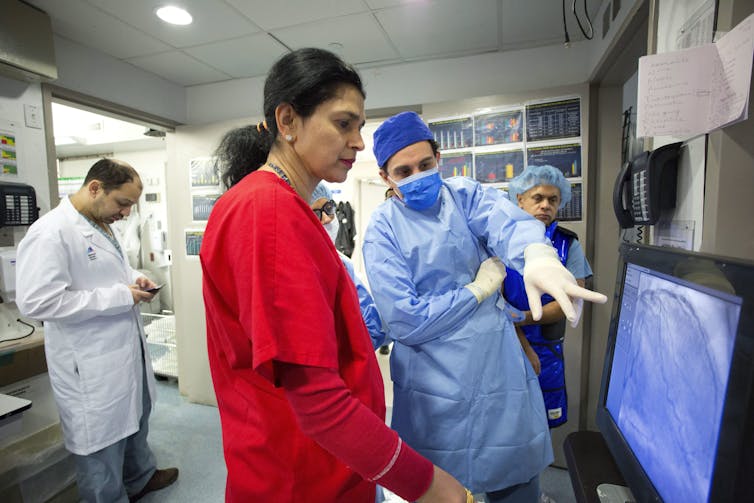Heart disease is the No. 1 cause of death for women throughout the world. Approximately seven times more women will die from heart disease than breast cancer. Even in women with breast cancer, dying from heart disease is a leading cause of death.
Yet when I ask undergraduate students in my chronic disease class (most of whom are female) which disease causes the most deaths in women, only about half give the answer heart disease; a third say it is breast cancer.
This mirrors a 2012 survey from the United States, which found that only 56 per cent of female respondents identified heart disease as the leading cause of death.
Such a lack of awareness has very real consequences. Women who experience a heart attack in the U.S. are more likely to misunderstand the symptoms and delay seeking treatment. In Canada, early heart attack signs were missed in 78 per cent of women, according to the 2018 Heart Report from the Canadian Heart and Stroke Foundation.
Our 2018 Heart Report focuses on why we still struggle to untangle and apply new knowledge about women and heart disease, and why some women often face even greater inequities. #HeartMonth https://cards.twitter.com/cards/18ce53uu8fk/5afjf …
So, why this dismal knowledge of heart disease in women?
Not just a “widowmaker”
One reason is that research has historically been conducted in middle-aged and older men. This is, in part, because men had heart attacks during their working years, potentially limiting their economic productivity.
Women — who tended to suffer heart disease at a later age — received less attention.
There was also a fear of involving pregnant women in research, which led to all women of child-bearing age being restricted from participating in most research in the U.S. until the 1990s.
As a result, people both within and outside the medical profession had the impression that heart disease is for men.

This bias is easily recognized by the term “widowmaker” to describe the left main artery: One of the key arteries of the heart in which a blockage may lead to early death.
Smaller hearts and arteries
The second reason for our general lack of understanding of heart disease in women is due to differences in biology. We now know that the findings from research in men don’t fully apply to women — given differences in risk for heart disease and in anatomy.
As women get heart disease later in life than men, they also have more age-related risk factors than men — such as diabetes, which makes treatment more complex.
Women with diabetes have a 44 per cent greater risk for heart disease than men. In addition, gestational diabetes (which occurs during pregnancy and impacts approximately 5.5 per cent of births in Canada), is associated with a higher risk for heart disease compared to women who haven’t had gestational diabetes.
Early age of puberty and menopause have also been associated with greater heart disease risk.
And differences extend to anatomy. Given their smaller body size, women tend to have smaller hearts and arteries than men. This has been associated with higher mortality during bypass surgery.
Smaller arteries also make diagnostic techniques like the electrocardiogram (ECG) and coronary angiography (X-ray imaging of heart arteries) more challenging.
Women have different symptoms
One of the more perplexing facts about heart disease in women is that a heart attack can occur even without any heart arteries being blocked. This can happen with a “coronary artery spasm,” in which an artery of the heart suddenly closes upon itself. And it can happen with “spontaneous coronary artery dissection,” in which the inside of the heart artery tears, leading to a blood clot.
When there is no blockage, diagnosis by traditional methods is difficult.

While women having a heart attack can feel severe pain in their chest, many also experience more subtle symptoms such as shortness of breath, discomfort in their arms, neck and jaw, sweating or nausea.
Despite these symptoms being fairly common in women, they are still referred to as “atypical,” indirectly suggesting that a woman’s experience is not normal. Yet they are normal for women.
A review of studies from nine countries found that women are also less likely to be referred to, and attend, cardiac rehabilitation programs.
And recent research from Sweden shows that failure to adhere to treatment guidelines results in greater premature death for women within five years after a heart attack compared to men. This confirms earlier findings in many other countries as well.
Female-only cardiac rehabilitation
While there is much work to be done, each year this gap in knowledge and treatment closes in North America thanks in part to Health Canada and the US Food and Drug Administration implementing guidelines to ensure the inclusion of women in research.
Continued advocacy by the Heart and Stroke Foundation and the American Heart Association is also important for increasing awareness both within and outside of the health care systems.
Additionally, more research in tailoring treatments to women, like female-only cardiac rehabilitation, will help in the design and application of treatments.
As individuals, the capacity to recognize and understand the signs and symptoms of heart disease could be life-saving — for our loved ones, friends, bystanders and even ourselves.
Author:Scott Lear: Professor of Health Sciences, Simon Fraser University
Credit link:https://theconversation.com/why-heart-disease-is-often-missed-in-women-the-myth-of-the-widowmaker-90530<img src="https://counter.theconversation.com/content/90530/count.gif?distributor=republish-lightbox-advanced" alt="The Conversation" width="1" height="1" />
The article was first published by The Conversation (http://www.theconversation.com) and is republished with permission granted to www.oasesnews.com



